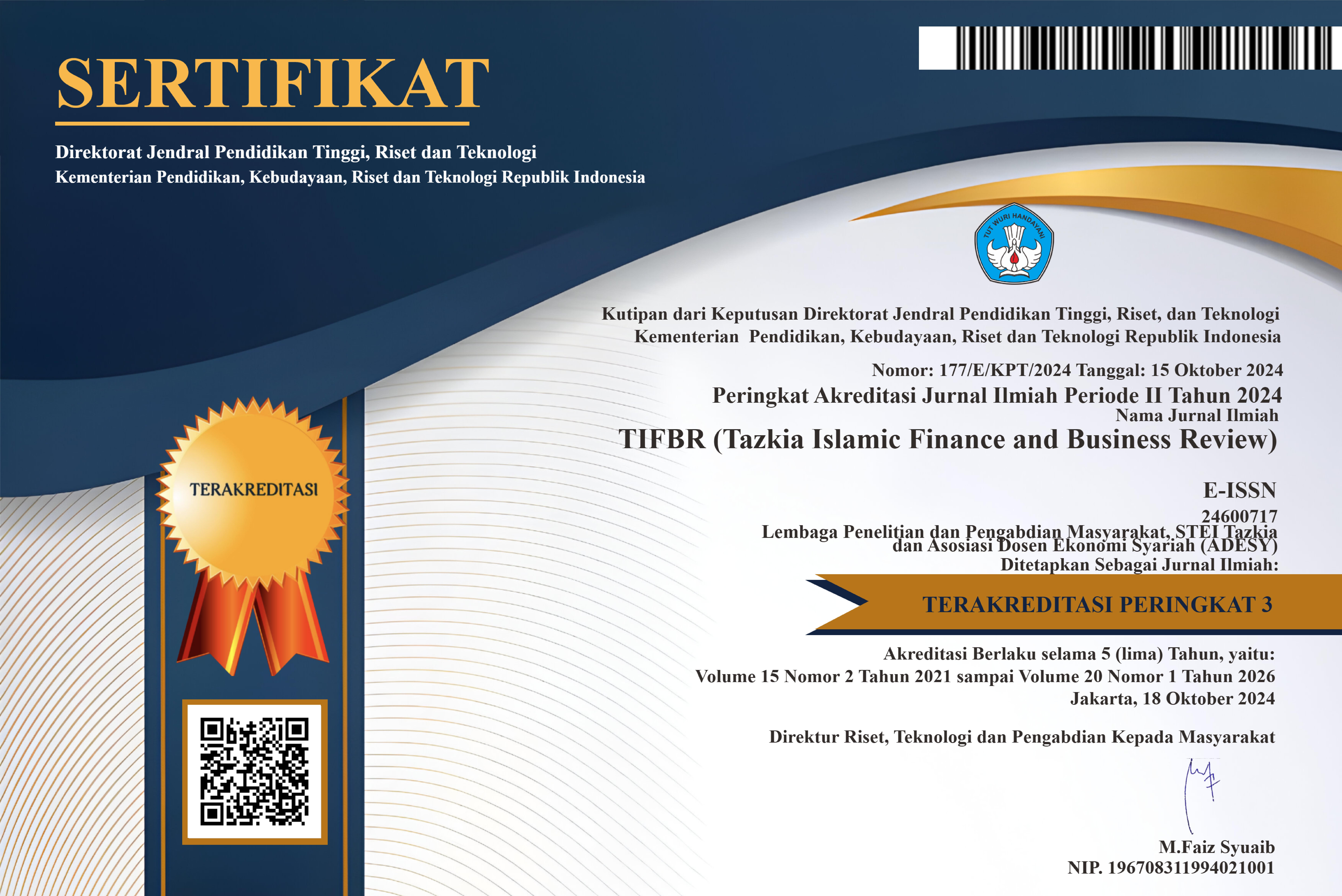Mobile Banking for Empowerment Muslim Women Entrepreneur: Evidence from Asia (Indonesia and Bangladesh)
DOI:
https://doi.org/10.30993/tifbr.v9i1.79Kata Kunci:
Women Entrepreneur, mobile banking, branchless banking,Abstrak
Objective - Women entrepreneurs have positive contribution to the household economy in particular, and the sustainable economic development in general. Nevertheless, there are limitations in mobility for women entrepreneurs, especially in Muslim countries to conduct their business activities outside the home, which was due to concern, to take care of their children, and the values or customs, which is embraced by the local community, so that limited mobility of women entrepreneurs, not because of the Islamic religiosity. Therefore, is requires form of technology solutions for women entrepreneurs, which can reduce, the limitations.
Methods - literature review
Results - the role of mobile banking as well as branchless banking for women entrepreneurs has been shown to have a very important role to connect their access to financial services. The role of education for women, is also an important factor to improve the knowledge and ability to use technology, including mobile banking services. In addition to the phenomenon of the increasing number of women entrepreneurs and the growing literacy of women in developing countries such as Indonesia and Bangladesh, it will have an impact on increasing the professionalism of women entrepreneurs, and the demand for technology-based financial services such as mobile banking.
Conclusions - Implementation of this program must have the support of all stakeholders, including the cooperation between the banks with microfinance institutions to expand the reach of the benefits of this technology.
Keywords: Women Entrepreneur, mobile banking, branchless banking,
Referensi
Cracknell, D. (2004), “Electronic banking for the poor—panacea, potential and pitfalls,” Small Enterprise Development, Vol. 15, No. 4.
Creevey and Lucy. (1996), “Changing Women’s Lives and Work: An analysis of eight microenterprise projects,”, London, Intermediate Technology Publications.
Davis, P. J. and Abdiyeva, F. (2012), “En route to a typology of the female entrepreneur? Sim¬ilarities and differences among self-employed women,” Journal of Management Policy and Practice, Vol. 13, No. 4.
Dewan, S. and Riggins, F. (2005), “The digital divide: current and future research directions,” Journal of the Association for Information Systems, Vol. 6, No. 12.
Ellitan, L. (2003), “Resources role in increasing influence of technology Producvity,” Journal of Management & Entrepreneurship, Vol. 5, No. 2.
Fatima, Y., Elizabeth, B., Jacinta, M., & Olga, M. (2012). “Best Practices in Mobile Microfinance”. Grameen Foundation.
Firdausy and Mulya,C .(1999), “Women Entrepreneurs in SMEs in Indonesia,” International Conference of Women Entrepreneurs in SMEs in the APEC Region, APEC Project on SME, 02/98, Singapore, APEC Secretary.
Global Entrepreneurship Monitor. (2010), “Women’s report”, Website: http://gemconsortium.org/
Husein, M. (2011), “Islam and the Working Woman Tafsir,” 12th edition. Available at: http: //www.rahima.or.id/index.php? option=com_content&view=article&id=667: Islam-and-the-working-woman-tafsir-12th-edition&catid=62: tafsir&Itemid=375
http://www.pewforum.org/2011/01/27/table-muslim-population-by-country/
Islam, M.S. (2013), “Mobile Banking: An Emerging Issue in Bangladesh,” ASA University Review, Vol. 7, No. 1.
Lyman, Timothy, Ivatury,G. and S. Staschen. (2006), “Use of Agents in Branchless Banking for the Poor: Rewards, Risks, and Regulation,” Focus Note 38, Washington, DC, CGAP. Available at: http://www.cgap.org/sites/default/files/CGAP-Focus-Notes-Use-of-Agents-in-Branchless-Banking-for-the-Poor-Rewards-Risks-and-Regulation-Oct-2006.pdf
Midas. ( 2009), “Women Entrepreneurs in SMEs: Bangladesh Perspective,”. Available at: https://www.google.be/search?q=Women+Entrepreneurs+in+SMEs%3A+Bangladesh+Perspective&oq=Women+Entrepreneurs+in+SMEs%3A+Bangladesh+Perspective&aqs=chrome..69i57.2141j0j7&sourceid=chrome&espv=2&es_sm=93&ie=UTF-8
Mobile Marketing Association. (2009), “Mobile Banking Overview,” Available at: https://www.google.be/search?q=mobile+banking+services&espv=2&es_sm=93&source=lnms&sa=X&ei=JQ4wU-38Csqc0AWd94GYAw&ved=0CAYQ_AUoAA&biw=1219&bih=715&dpr=1#q=mobile+banking+overview
Mohammad, G. and Retnowati, Grace (2014) “Draft Banking Regulations in Indonesia-A Review, Microsave, available at: http://blog.microsave.net/do-the-new-regulations-in-indonesia-foster-growth-of-branchless-banking-well-almost/
Moyes, T. (2011), “The World Bank invites Bank Mandiri to develop branchless banking,” Indonesian Bankers Asociation. Available at: http://ikatanbankir.com/ibi/article.php?id=1046
Porteous, D. (2006), “The enabling environment of m-banking in South Africa,”. Available at: http://www.microfinancegateway.org/p/site/m/template.rc/1.9.25001/
Rushandie, R. (2014), “Branchless Banking Lebih dari Sekedar Jargon Marketing”, Kompasiana, available at: http://ekonomi.kompasiana.com/moneter/2014/10/30/branchless-banking-lebih-dari-sekedar-jargon-marketing-683535.html
Rouf, A.K. (2012), “Green microfinance promoting green enterprise development,” Humanomics, Vol. 28, No.2.
Seers, D. (1997), ``The meaning of development,” The Society for International Development, Vol.40, No. 1
Social Watch Report. Available at: http://www.socialwatch.org/Statistic Report of Ministry of Cooperatives and Small and Medium Enterprises Republic of Indonesia. Available at: http://www.depkop.go.id/index.php?option=com_phocadownload&view=file&id=394:perkemb ngan-data-usaha-mikro-kecil-menengah-umkm-dan-usaha-besar-ub-tahun-201-2012&Itemid=93
Suratmi, Siti, M. T., Mohammad, R., Umi, R. (2011), “Entrepreneurial Education Program Gender Perspective Catering based in Pesantren Salaf,” Journal of Business Economics, Vol. 1.
Tambunan, T. (2012), “Women Entrepreneurs in MSMEs in Indonesia: Motivation and Obstacle,” Center for Industry SME and Business Competition Studies, Trisakti University, Policy Discussion Paper Series, No. 33/01/2012.
Warschauer. (2004), M. Technology and Social Inclusion: Rethinking the Digital Divide. Cambridge: MIT Press.
##submission.downloads##
Diterbitkan
Cara Mengutip
Terbitan
Bagian
Lisensi

Tazkia Islamic Finance and Business Review (TIFBR) is licensed under a Creative Commons Attribution-NonCommercial 4.0 International License.
Authors who publish with this journal agree to the following terms:
- Authors retain copyright and grant the journal right of first publication with the work simultaneously licensed under a Creative Commons Attribution License that allows others to share the work with an acknowledgment of the work's authorship and initial publication in this journal.
- Authors are able to enter into separate, additional contractual arrangements for the non-exclusive distribution of the journal's published version of the work (e.g., post it to an institutional repository or publish it in a book), with an acknowledgment of its initial publication in this journal.
- Authors are permitted and encouraged to post their work online (e.g., in institutional repositories or on their website), as it can lead to productive exchanges, as well as earlier and greater citation of published work (See the Effect of Open Access).

















